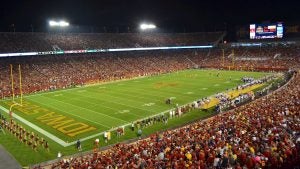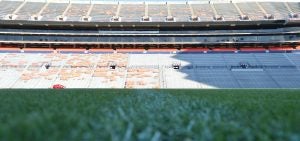As we really get into the college football season, no matter who you cheer for, we need to recognize and appreciate all of the people who make the sport possible. Not just the football players, or the coaches, or the fans, but also the farmers. That’s right, turf grass farmers make our favorite fall (and winter) sport possible.
It’s harder to make grass grow on a football field (or any sports field for that matter) than it is to grow the grass in your front yard. There is a lot of science, precise measurements, and work that goes into making that field green for our favorite players to run on week after week.
Tim VanLoo, athletics grounds manager at Iowa State University, explains some of the process of managing about 55 acres of athletics, practice, and game fields at his university.
“Managing an athletic field really comes down to making sure the irrigation is running properly, mowing, and doing the agronomic side as well,” VanLoo said. “Cultivating, top dressing, fertilizer and pesticide application, painting the field. Literally everything that has to do with the outside of the field, and water run-off issues as well.”

The benefits of a real turf field are numerous, with the main one for most places being that is cheaper to maintain that an artificial field. But when maintained well, it can also help the environment by limiting weeds and preventing water runoff into rivers and lakes.
“For us in Iowa, we have flash flooding,” said VanLoo, who’s been with the school since 2010. We can easily have over five and half inches of rain in three hours. If a large percentage of our fields were artificial, that water is going to hit that river system much quicker. Having natural grass slows the water down and utilizes it in a way it’s supposed to be used, growing something.”
Another way that real turf fields can help is in education, especially at agricultural and land-grant universities. Having a field that students can work on can provide them with valuable hands-on experience that employers are looking for after graduation.
“Beyond that, being Iowa State, being an agricultural school, having a turf grass program allows me to employ students that want to be sports turf managers,” VanLoo said. “It allows us to have that commitment to the students.”
There are numerous colleges throughout the nation that agree with that statement and offer a turf grass management option for their students, and hands-on experience in the field. The professors, students, and managers love the field and want to make it the best they can. Not only for themselves, but for the athletes who are going to be playing on it and for the spectators. Growing grass on a sports field is difficult business, so most people have a college degree in turf grass management, along with getting continuing education.
“I think the biggest misconception in sports turf management is that we’re not professionals. Many of the people in this profession, are just that. Professionals,” VanLoo explained. “They’re college-educated and a part of an association as well.”
VanLoo proves this point because he has a master’s degree from Michigan State and is the president of the Sports Turf Managers Association.
The association strives to constantly improve the industry. It advances professionalism in sports field management and safety through education, awareness programs, and industry development.
These associations help with continuing education, which is incredibly important in any industry. It helps turf grass management experts combat the ever-changing struggles of their industry. One struggle that that never changes is trying to make fields grow in football season, which usually happens to be the plant’s dormant season. This problem is not exclusive to northern regions, or to turf grass; it is a problem that all of agriculture encounters — working with Mother Nature.
“If it is cold, we have to do things to make the grass grow,” VanLoo said. “We’re covering it, putting lamps out there, and trying to keep the soil warm. In addition, in the spring, the players and coaches want to get out there as early as possible to start practicing, but the fields are still dormant. So getting them to look right and to take the wear and tear of practices is tough. Especially when the soil temperatures aren’t allowing for proper growth.”

However, improving the industry, contending with Mother Nature, and making sports fields possible is not all work and no play.
“My favorite part of my job is the Saturdays when you have this placed packed and they get to appreciate the handiwork,” VanLoo said. “Football Saturdays, when everyone is here, the field is looking top-notch and playing well. That’s my favorite part of it all.”
VanLoo’s second favorite part is that what he does is still involved in the agriculture industry. His father still farms, so he has the ability to discuss how that affects both their jobs. The same goes for farmers that he sees around his state.
“If I walk into a place and there are five farmers there, we can have a very good conversation about the things that are alike and the things that are different,” VanLoo said. “All in all, the agriculture is the same, and the end goal is the same. We’re all just trying to grow a healthy plant.”



